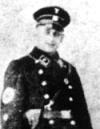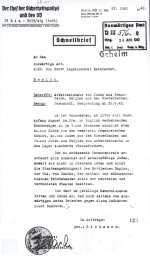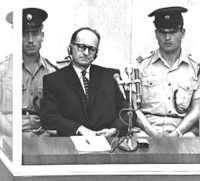Biographical Details
 |
| Eichmann |
Otto Adolf Eichmann was born on
19 March 1906 in
Solingen, Germany. In
1913, the
Eichmann family moved to
Linz (Austria), where Adolf Eichmann was educated.
His education incomplete, he left school in
1921. He worked at a variety
of jobs, the most successful being as a sales representative for the
Vacuum Oil Company. At the prompting of
a family friend,
Ernst Kaltenbrunner, he became a member of the Nazi Party in
April 1932 (NSDAP number 899895). He was dismissed from his job with the
Vacuum Oil Company in
1933, by which
time he was already a member of the SS (SS number 45326).
Eichmann left Austria for Germany in
August 1933, where he underwent military
training. He applied for a transfer to
the SD and was accepted in
September 1934, taking up a position in the SD main office in
Berlin, headed by
Reinhard Heydrich.
Over the next months, Eichmann immersed himself in the bureaucratic world of files and card indexes. He was a diligent
and efficient worker, who achieved steady promotion, eventually reaching the rank of
SS-Obersturmbannführer.
In
1935, Eichmann was moved to Department II/112, the Jewish office within the SD. See his
Personalbericht from
1937!
By dint of much effort, he was eventually recognized as the
SD's "expert" on Jewish affairs, and in that capacity
was sent to
Vienna in
1938 following the
Anschluss, to organise Jewish
emigration, a task he performed with such ruthless efficiency that he was subsequently called upon to conduct a
similar operation in
Prague.
 |
| Eichmann in 1939 |
On
27 September 1939,
Himmler created the
RSHA (
Reichssicherheitshauptamt
– Reich Security Main Office), unifying the existing conglomeration of security services and police into a single
command headed by
Heydrich. Eichmann now reported to
Heinrich Müller, the chief of the
Gestapo, who appointed Eichmann
head of the Central Office for Jewish Emigration from the
Reich, operating from
Berlin.
With the outbreak of war, Eichmann oversaw a fundamental change in policy – from "voluntary" emigration to forced
deportation. During
1939-40, he and his team, which was to eventually include men such as
Franz Novak, Rolf Günther, Dieter Wislicency, Otto Hunsche, Hermann Krumey, Theodor
Dannecker and
Heinz Röthke, amongst others, were responsible
for the dumping into the
Generalgouvernement of thousands of Poles and Jews from the
Warthegau, as well
as the expulsion of thousands more Jews from the
Reich to
Nisko, in eastern
Poland. These operations provided valuable experience for the mass Europe-wide deportations that were to come.
 |
| Letter from June 1942 |
In
March 1941, a reorganisation of the RSHA occurred, as a result of which the
Jewish section was designated
Department IVB4, with Eichmann as its head. His subsequent activities and responsibility for the death of millions
of Jews following the decision to implement the "Final Solution of the Jewish Question" in
1941 have been well documented elsewhere.
With the defeat of Germany in
1945, Eichmann, whose criminal activities were
scarcely known at that time, escaped
from
Ober-Dachstetten POW Camp and went into hiding in West Germany. Under an
assumed name, he worked first as a forester and then as a chicken farmer, before in
1950,
following the trail of
many other Nazi fugitives, he migrated via Italy to Argentina. There, the Fascist regime of
Juan Peron was only too ready to welcome him and his kind. Now under another
assumed name,
Ricardo Klement, he awaited the arrival of his wife and two sons,
who eventually joined him in
1952.
For almost the next 8 years, Eichmann lived modestly at a number of different locations and worked in a variety of
equally modest jobs. By the
late 1950's, the centrality of Eichmann's importance in
the programme to exterminate the Jews had emerged.
After a tortuous process, the Mossad (Israeli Secret Service) was able to prove Eichmann's true identity. A team
was dispatched to
Buenos Aires, where Eichmann was then living, to bring him
to Israel to stand trial for his crimes. In
May 1960, Eichmann was abducted and flown
to Israel. Over the next
9 months, he was subjected to an intense interrogation, which eventually extended to tape recordings lasting 275
hours, producing a transcript of 3,564 pages.
 |
| Trial |
Eichmann's trial began on
11 April 1961 and concluded on
15 December 1961. Despite his unquestionably being aware
of the nature of
Aktion Reinhard and its consequences, Eichmann had little direct connection with that
operation itself. Nor was he an instigator of Nazi extermination policy, which was dictated by others. His
administrative position of
Referent and his rank in the SS clearly indicate that he was only able to issue orders
and instructions based upon the authority vested in him by others. But he was an able and enthusiastic executor
of that authority, who pursued his appointed task with a zeal that eventually bordered on fanaticism. Although with
the benefit of subsequent research, particularly since the availability of archival material from the former
Soviet Union in the
1990's, it is possible to see that the prosecution's evidence
against him was in some cases
flawed, and that certain witness testimony, whilst of enormous historical significance, was of little or no
relevance to Eichmann's activities, the magnitude of his crimes and the question of his guilt were never in doubt.
He was sentenced to death. An appeal against the sentence having failed, he was hanged at midnight on
31 May 1962.
It remains the only death sentence to have been carried out in the history of the state of Israel. Eichmann's body
was cremated in a temporary facility that bizarrely replicated the scenes at
Auschwitz,
Chelmno,
Belzec,
Sobibor,
Treblinka, and
Majdanek. His ashes were taken in a launch to
a point outside Israeli territorial waters and cast into the Mediterranean.
It is impossible to overstate the importance of Eichmann's trial in the historiography of the Holocaust. For 15
years, there had been little meaningful discussion of the subject. The trial stirred a new generation into examining
the topic in depth for the first time. It began a process of research and scholarship that continues to this day,
and not least, provided the impetus for many of the subsequent trials of Nazi criminals in Germany.
Eichmann in the East
In
May 1960 Adolf Eichmann was interrogated by
Avner
W. Less, a captain in the
Israeli police. Eichmann admitted during the interrogation that at a meeting with
Heydrich, he was informed that the "the
Führer has ordered the physical
extermination of the Jews".
Heydrich ordered Eichmann to visit
Odilo Globocnik, the
SS- und Polizeiführer im Distrikt
Lublin, who had already been authorised by
Himmler to begin this task.
Eichmann was to report on
Globocnik's methods.
Heydrich thought
Globocnik was using
Russian anti-tank trenches for the mass shooting and burial of Jews. Eichmann initially dated receipt of these
orders to the late
summer or early autumn of 1941. There is circumstantial evidence
that there was possibly a
delay of 2-3 months between Eichmann receiving his orders and his visit to
Lublin. In any event, there is no doubt that Eichmann did go to
Lublin and reported to
Globocnik,
who instructed
Hermann Höfle, a member of the
Aktion Reinhard staff, to show Eichmann around.
Eichmann and
Höfle went from
Lublin to
Belzec. Eichmann described the site; there were patches of woods, and a highway
passed through it. On the right hand side of the road there was an ordinary house, where the men who worked at the
camp lived. A captain of the regular police (
Ordnungspolizei) welcomed them. This was
Christian Wirth. A few workmen were still there.
Wirth took off his jacket, and rolling up his sleeves, joined in the
work. Two or three small wooden shacks resembling two or three room cottages were being erected.
Höfle told
Wirth to explain the
installation to Eichmann, which he did.
Wirth told Eichmann that he had
made everything airtight. It seemed that they were going to connect a Russian submarine engine to the buildings
and pipe the exhaust fumes into them, gassing the Jews inside. Eichmann told
Less
that he was "horrified" by this prospect.
Eichmann was unsure (probably deliberately) whether it was
Belzec or
Treblinka he had visited, but the dating makes it certain that it was
Belzec. Eichmann stated that "it was in the latter part of
1941 that I saw some
of the first preparations for the annihilation of the Jews", but the visit was probably at the
beginning of 1942,
when the gas chambers were finished and awaiting the arrival of the first transports to the camp (see
Aktion Reinhard and the Emergence of "The Final Solution" for an alternative
interpretation of Eichmann's visit).
His visit to
Belzec was connected with the start of the deportations of
Czech Jews from
Terezin (Theresienstadt) and the mass deportation of Jews from Slovakia,
both to the
Lublin district.
Between March and June 1942, the Jews from the
Czech and Slovakian regions were deported to
transit ghettos in
Izbica, Zamosc,
Rejowiec, Chelm, Piaski, Lubartow, Miedzyrzec Podlaski, Deblin and
Opole
Lubelskie, to the concentration camp at
Majdanek and directly to
Sobibor. The total number deported amounted to 14,000 Czech and 39,889
Slovakian Jews, of whom 6,900 Czech and 9,700 Slovakian Jews were murdered in the
Belzec gas chambers.
Heinrich Müller, the head of the
Gestapo, next ordered Eichmann to
report on the use of
gas vans at
Chelmno, where he witnessed the vans in
operation, a sight Eichmann claimed to find nauseating. Following this,
Müller sent Eichmann to
Minsk, where
he saw a mass shooting conducted by
Einsatzgruppe B. He returned via
Lwow, passing by a killing site where blood spurted from the burial pit
"like a fountain."
Continuing his tour of murder sites, Eichmann then received orders from
Müller to pay another visit to
Globocnik,
whom he saw in
Treblinka, where the gassing installations were in operation.
Eichmann expected to see a wooden house on the right hand side of the road with a few more wooden houses on the
left, as he remembered from
Belzec. Instead, again accompanied by the same
Sturmbannführer Höfle, he arrived at a camp with a replica
railroad station bearing a sign saying "
Treblinka". It resembled the type of
station that might be seen anywhere in Germany. Eichmann said that he hung back as far as he could during the
gassing. He didn’t push closer to see it all. He saw a footbridge enclosed in barbed wire and over that footbridge
a file of naked Jews was being driven into a big house to be gassed. Since it is known that the fake railway
station at
Treblinka was only constructed in
late December 1942, Eichmann's
visit can be dated as being sometime in
1943. Eichmann also admitted that after the
Wannsee Conference,
Heydrich
instructed him to provide ex post facto written authorisation to
Globocnik
regarding the killing of Jews as part of the "Final Solution".
Eichmann admitted during his trial that he visited
Belzec and
Treblinka, but strenuously denied having ever been in
Sobibor. A number of witnesses claimed to have seen him in
Sobibor (for example
Moshe Bahir), sometimes
accompanying
Himmler, who certainly did visit that camp, but the witness
testimony did not withstand scrutiny.
Jacob Frank, a Jewish native of
Lublin,
was the SS-designated supervisor of the tailoring department at the
Lipowa Street Labour Camp in
Lublin.
He recalled a
1942 inspection of the
Lipowa Street labour camp, that involved Eichmann, who was escorted by
Globocnik, Maubach, Mohwinkel, Schramm, Klein, Hantke, and the
SS-Standartenführer von Alvensleben. Eichmann certainly paid other
visits to
Lublin. For example,
Globocnik
and Eichmann met in
Lublin again on
9 July 1943,
after
Globocnik asked Eichmann to bring a pass for
Walter
Caspar Többens, a German businessman who employed 4,500 Jewish workers in his
Warsaw ghetto workshops.
German Police Decodes & Related Activity
In a message dated
24 August 1942 from
Globocnik
to
Rolf
Günther (
Eichmann’s deputy in the RSHA department IVB4)
concerning the evacuation of Rumanian Jews, it was stated that all
deportation trains should be directed to
Trawniki, from where further distribution would take place. The
police decode is legible, but not of a quality good enough for reproduction.
A conference was held at the Ministry of Transport in
Berlin on
26 and 28 September 1942 to discuss the transportation requirements for the
deportation of an additional 600,000 Jews from
the
Generalgouvernement and the expulsion of 200,000 Jews from Rumania to
Belzec. The conference was attended by either Eichmann or
Günther,
Steir (
GEDOB),
and headed by
Klemm (Ministry of Transport).
The following was decided:
Evacuation of the Polish Jews
Urgent transports as proposed by the Chief of the Security Police and SD:
2 trains daily from the
Warsaw District to
Treblinka
1 train daily from the
Radom District to
Treblinka
1 train daily from the
Krakow District to
Belzec
1 train daily from the
Lwow District to
Belzec
These transports will be carried out with the 200 freight cars already made available for this purpose by order
of the Directorate of the German railways in
Krakow, as far as this is possible.
Upon completion of the repair of the
Lublin – Chelm railway line, in about
November 1942, the other urgent transports will also be carried out. These are:
1 train daily from the
Radom District to
Sobibor
1 train daily from the north
Lublin District to
Belzec
1 train daily from the central
Lublin district to
Sobibor
insofar as this is practicable and the required number of freight cars are available. With the reduction of the
transports of potatoes, it is expected that it will be possible for the special train service to be able to place
at the disposal of the Directorate of the German railway in
Krakow the necessary
freight cars. Thus the train transportation required will be available in accordance with the above proposals and
the plan completed this year.
The deportation of the Rumanian Jews to
Belzec did not materialise, due to a
number of factors, including internal squabbles within the Rumanian administration, a protest submitted by the
United States to the Rumanian government in
September 1942, and various efforts
by Jewish leaders within Rumania.
One of the most important messages partially intercepted by the British was the year- end report on
Aktion
Reinhard, sent by
Höfle to Eichmann on
11 January 1943 and marked
Geheime Reichssache. A second message to
SS-Obersturmbannführer
Heim, BdS
Krakow, was probably identical,
and whilst coded, indicates the number of victims of
Belzec, Sobibor, Treblinka
and
Majdanek for the calendar year
1942.
Messages to Eichmann
Eichmann's Helpers
Sources:
Eichmann Interrogated. Jochen von Lang, Da Capo Press,1999.
Hitler’s Man in the East – Odilo Gobocnik. Joseph Poprzeczny, McFarland 2004.
Public Records Office – Kew.
Belzec, Sobibor, Treblinka.Yitzhak Arad, Indiana University Press,1987.
Bundesarchiv in Ludwigsburg, II-208 AR 643/71, The documents of the investigations against Karl Streibel and
others, Vol. IV.
Migracje ludnosci w dystrykcie lubelskim w latach 1939-1944 (Migrations of the population in the Lublin District
in the Years 1939-1944). Janina Kielbon, Lublin, 1995.
Fateful Months – Essays on the Emergence of the Final Solution. Christopher Browning, Holmes & Meier, 1991.
Eichmann – His Life and Crimes. David Cesarani, William Heinemann, 2004.
Encyclopedia of the Holocaust. Israel Gutman, ed. Macmillan Publishing Company, New York, 1990
www.nizkor.org
www.pbs.org
© ARC 2005










